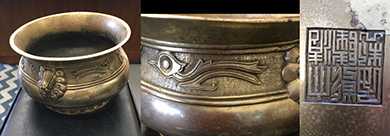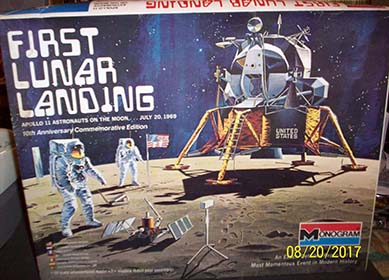 |
|
|||
 |
 |
|||
Copyright © Harry Rinker, LLC 2017 Questions
and Answers
QUESTION: I recently purchased a Chinese metal, possibly pewter, vessel for $25.00. It has a wide flared rim beneath which is a collar band with an elaborate Greek key background and two relief abstract birds. The bulbous body rests on a rim foot with a swirl design. The applied heavy relief handles appear to be a lion’s face. There is a stamp on the bottom. The story behind the vessel is interesting. While at a scrap yard, I overheard a couple talking with a scrap dealer of Chinese origin about the scrap value of the vessel. The dealer’s father overheard the conversation, looked at the piece, got excited, and offered several hundred dollars. The couple refused based on the “if he is willing to pay this, someone is willing to pay more” theory. When they asked for more, the father became insulted and refused any further conversation. I took the couple’s card, called them, and offered to buy the piece. How do I view what happened, and how did I do? – KT, Madisonville, KY, Email Question 
ANSWER: Understanding aesthetics and quality is a skill that many collectors lack. They are so book focused that they have difficulty dealing with objects that cannot be researched. As a result, these collectors are afraid to take a chance on an object with a low price for fear of getting stung. Everything about your metal vessel suggests quality. The workmanship is detailed and exquisite. The work is hand work, not the product of a machine. The mark on the bottom is not typical of cheap imports. While I very much wanted the mark to be a maker’s mark, my first thought was a dynasty seal mark. Although there are no internet or easily obtainable guides to Chinese metal dynasty seal marks, I assumed they closely resemble those used on ceramics. In this case, the antiques and collectibles field is fortunate to have access to Gotheborg.com (http://gotheborg.com/marks/20thcenturychina.shtml), the first place I turn to when trying to identify a mark on Chinese ceramics. Assuming the vessel dated after 1900, I went through the seal marks one dynasty at a time between 1900 and 1949. I was frustrated when I did not find the mark. Using the prominent “L” corner in the mark, I went through the dynasty seal marks again. Eventually, I found a Da Qing Qianlong Nian Zhi (Great Qing Qialong Period) mark from the mid-20th century that was nearly identical. As it turned out the picture you sent of the mark had it upside down. Your vessel was made between 1930 and 1949. My initial guess was a much earlier date. I was wrong. If someone offers me “x,” there must be someone who will offer me “x” + is a false concept. The Chinese scrap dealer’s father may have been buying from his heart rather than his head. His offer may have been top market. Greed is a dangerous thing. All it got the couple was $25.00. My recommendation is to continue researching the vessel. There are enough decorative elements that it may be possible to determine the maker. Given what is known at the moment, its value is in the $150.00 to $200.00 range, albeit not in Madisonville, KY. These are big city numbers. If you do want to sell it without doing further research send it to a mid-range auction in close proximity to New York, for example Nye & Company. These auctions use the internet to reach international bidders. If placed at auction, the piece is most likely to travel “back across the rim.” QUESTION: My brother who is in poor health is a rabid New York Yankees fan. He has a collection of around 300 books dealing with anything Yankees, a variety of autographed pictures, and every Yankees yearbook since the first one was issued in 1950. I have two questions. First, is the value of the collection as a whole greater than selling off the individual parts? My brother would like to see someone take the entire collection and keep it intact. Is this realistic? Thus far he has had no luck on this latter point. The local library would take some of the books but not all of them. If filed by the Dewey decimal system, the books would not stay together. Friends have recommended the collection be sold piecemeal on eBay. I welcome your thoughts. – DK, Reading, PA, Email Question ANSWER: Your brother’s dream is not a reality. No buyer or institution to which the collection is donated is going to keep the collection intact. Sellers have a hard time letting go. Once the collection is sold, it no longer belongs to the previous owner. No matter what the buyer promised, he/she as the right to decide what happens next. The first thing you need to do is check to see if any of the books or yearbooks are autographed. All autographs, especially those on the photographs, will have to be authenticated. Fortunately, your brother is alive to help in the process. Ask if he stood by and watched as players signed photographs, books, or yearbooks. If yes, put these aside. The FBI estimates that over 80% of sports signatures on the market are fake. If your brother did not see the person sign the autograph, you face a daunting task. If your brother wants to sell the collection as a whole, he needs to determine a price. A run of Yankee yearbooks is worth over $2,000.00. 300 books at $5.00 each, assuming none are autographed, adds $1,500.00. I am certain your brother thinks the per book value is higher. If the photography signatures are authentic and several of the players are in the Hall of Fame, they represent an additional $1,000.00 or more. As the mice in Disney’s “Cinderella” sing, “Add it together and what have you got,” the answer is $4,500.00 minimum. The real answer is that no one is going to pay that for the collection. $1,500.00 will sell the collection quickly. $2,500.00 might sell it but your brother and/or you will work hard to achieve it. Your brother needs to set a price; and, the two of you need to work from there. Consider placing an advertisement on Craigslist in mid-November (or earlier if somehow the Yankees miraculously win the 2017 World Series) for the collection. Try the “Perfect Christmas Gift for a Yankees Collector” pitch. If the collection does not sell, try the advertisement one more time just before the opening of Spring Training. Another alternative is sending the material to an auction house that specializes in Sports auctions. My suggestion is Hunt Auctions, LLC, located in Exton, Pennsylvania. Parting may be such sweet sorrow in Shakespeare’s time, but, it may not be for your brother’s collection in his lifetime. Watching his collection pass from his to another’s hands will be painful. It may be better to wait. QUESTION: I have an unbuilt Monogram “First Lunar Landing” 1:48 model kit. It has been sitting on my shelf for over 40 year. What is it worth? As an aside, thieves broke into the Neil Armstrong Museum in Wapakoneta, Ohio, and stole a solid gold model of the first Lunar lander made by Cartier of Paris. Most likely it will be melted down and sold for its metal content. What a tragedy. – JK, Timberlake, OH, Email Question 
ANSWER: Apollo 11 Mission commander Neil A. Armstrong became the first man to walk on the moon on July 20, 1969. “Where were you when you learned that Neil Armstrong stepped onto the moon’s surface” is a generation defining question. I watched the step “live” on a black and white television in the basement of my home on Drury Lane in Bethlehem, Pennsylvania. Forty subtracted from 2017 is 1977. I found it hard to believe that Monogram waited until 1977 to issue a model kit. Unravelling the mystery led to a “what happened to the original dies and printing plates” story. The first Monogram “First Lunar Landing” has a 1970 copyright. The rectangular logo on the bottom left of the box has Monogram in a blue banner above “quality hobby kits” on a red banner adjacent to a square with a black ground and a white, waist portrait of a young boy holding a rocket. Monogram kept reissuing the kit. I found copyrights for a 1979 and 1993 reissued kit. In 1994, Revell/Monogram, using the period dies and printing plates, reissued the First Lunar Landing model kit in a 25th anniversary edition. Should collectors expect a 50th anniversary edition from the period dies and plates in 2019? In addition to these variations, Revell used basically the same dies but an altered cover printing plate when it issued its #5087 Rocket Hero Buzz Aldrin 1:48 Lunar Landing kit. It further recycled the kit as Monogram’s Young Astronauts First Lunar Landing model kit in 1986. Using your box design for comparison, your Monogram First Lunar Landing model kit is the 1979 version, meaning your “sit on the shelf” number is off by a few years. Things like this happen the older one gets. Age does not appear to make that much difference in secondary market value. The average asking price on eBay for 1970, 1979, 1993, and 1994 kits is around $35.00 with an additional $8.00 to $10.00 requested for shipping. Since none of these appear to be selling, a more realistic value is between $25.00 and $30.00. This reflects the high survival rate of these kits. Harry L. Rinker welcomes questions from readers about
collectibles, those mass-produced items from the twentieth and twenty-first centuries.
Selected letters will be answered in this column.
Harry cannot provide personal answers.
Photos and other material submitted cannot be
returned.
Send your questions to: Rinker on Collectibles, 5955 Mill
Point Court SE, Kentwood, MI 49512.
You also can e-mail your questions to
harrylrinker@aol.com.
Only e-mails containing a full name and mailing address
will be considered.
You can listen
and participate in
WHATCHA GOT?, Harry’s
antiques and collectibles radio call-in show, on Sunday mornings between 8:00 AM
and 10:00 AM Eastern Time.
If you
cannot find it on a station in your area,
WHATCHA GOT?
streams live on the Internet at www.gcnlive.com.
SELL, KEEP OR TOSS?: HOW TO DOWNSIZE A HOME,
SETTLE AN ESTATE, AND APPRAISE PERSONAL PROPERTY
(House of Collectibles, an imprint of Random House Information Group, $17.99),
Harry’s latest book, is available at your favorite bookstore and via
www.harryrinker.com.
|
||||